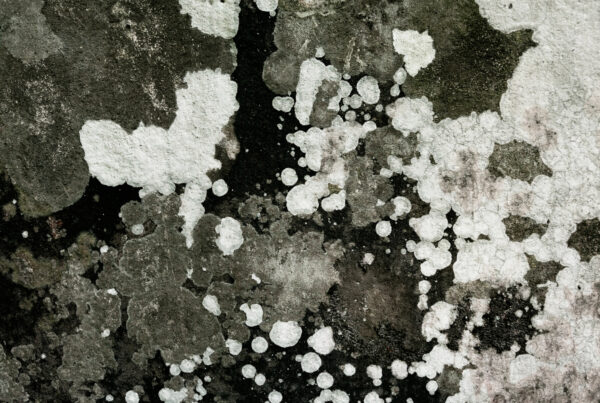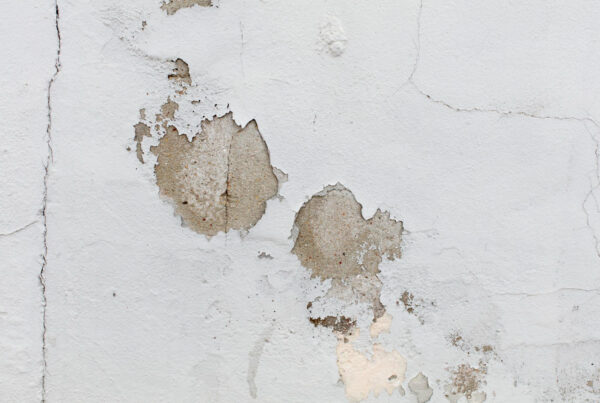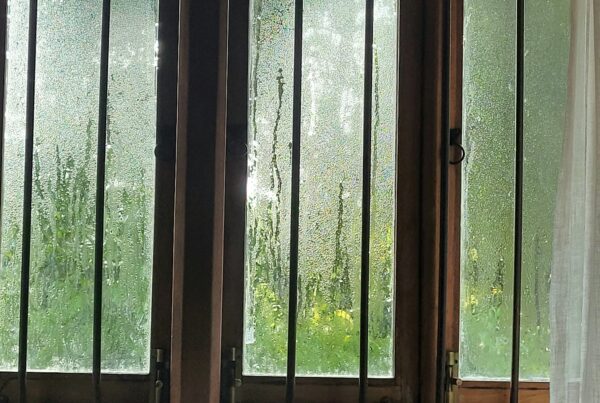Condensation inside windows forms when warm, humid air meets cold glass surfaces, creating water droplets that damage window frames, cause mould growth, and obscure your view. Understanding the specific condensation causes inside windows can help homeowners implement targeted solutions to prevent moisture damage and safeguard healthy indoor environments.
Let us explore the science behind window condensation, identify the contributing factors, reveal practical prevention methods that work, and explain when professional help is needed to protect your property.
Understanding What Causes Condensation Inside Windows
Condensation inside windows stems from a physical process: warm air carrying moisture touches cold surfaces below the dew point temperature, transforming water vapour into liquid droplets. Windows, being the coldest surfaces in most rooms during winter, become prime locations for moisture to condense.
Temperature differences between the inside and outside create the conditions for condensation on windows. Single-glazed windows experience more condensation than double-glazed windows due to less insulation, making the inner panes colder.
Indoor activities generate surprising amounts of moisture – cooking releases 3 litres of water vapour daily, while a family of four produces a significant amount through breathing, showering, and daily activities. This moisture cannot escape well-sealed modern homes, creating persistent window condensation problems.
Common Factors Contributing to Window Condensation
Several household conditions combine to create condensation, which causes issues inside windows in some UK homes.
Poor ventilation and air circulation
- Blocked trickle vents preventing continuous background ventilation
- Unused or broken extractor fans in bathrooms and kitchens
- Sealed rooms with no air exchange, trapping humid air
- Closed internal doors preventing air circulation between rooms
- Windows never opened, allowing moisture accumulation
Our specialists at Refresh consistently identify poor ventilation as the primary factor affecting window condensation.
Excessive indoor moisture production
- Unvented tumble dryers releasing steam directly into rooms
- Cooking without lids or extractor fans operating
- Long showers without adequate bathroom ventilation
- Houseplants and fish tanks contributing to ambient humidity
Temperature management issues
Inconsistent heating creates cold spots where condensation forms readily. Turning the heating off overnight allows surfaces to cool below the dew point. Keeping curtains closed traps cold air against the windows. Poor insulation around frames results in thermal bridges where condensation inside windows concentrates.
7 Practical Ways to Stop Window Condensation
Apply these best practices to reduce instances of window condensation.
1. Open windows daily for ventilation
Open windows on opposite sides for 10-15 minutes each morning to create cross-ventilation. This rapid air exchange removes humid indoor air without cooling your home’s structure.
2. Use trickle vents properly
Keep trickle vents open year-round – they provide constant background ventilation without draughts. Some homeowners do not realise these vents should remain permanently open.
3. Install and use extractor fans
Run bathroom fans during showers, continuing 20 minutes afterwards. Kitchen extractors should operate while cooking and stay on to remove steam. Humidity-sensing fans automatically activate when moisture rises.
4. Maintain consistent room temperatures
Keep background heating at 15-18°C minimum instead of allowing rooms to cool completely. Consistent temperatures prevent surfaces from dropping below the dew point.
5. Use dehumidifiers strategically
Place dehumidifiers in problem areas where condensation on windows persists. Units that remove around 10-12 litres daily can help reduce indoor humidity.
6. Move furniture away from external walls
Create 10cm gaps between furniture and external walls, allowing air circulation. This prevents cold, damp microclimates where condensation inside windows may spread.
7. Dry clothes outdoors or in vented spaces
Avoid drying laundry on radiators. Use vented tumble dryers, outdoor lines, or dedicate one well-ventilated room with a dehumidifier for drying.
When Window Condensation Indicates Serious Problems
Persistent condensation despite prevention measures suggests underlying issues that need professional assessment.
Between double-glazing panes
Condensation between sealed double-glazed units indicates seal failure that needs window unit replacement. The insulating gas has escaped, compromising thermal efficiency. Failed seals worsen over time.
Excessive condensation with mould growth
Black mould around frames signals moisture problems beyond normal condensation, indicating potential structural dampness or ventilation failures. We provide comprehensive damp proofing solutions that address the root causes of persistent moisture.
Structural dampness indicators
- Water pooling on windowsills damaging paint and wood
- Plaster damage or bubbling paint near windows
- Rotting or warping window frames from persistent moisture
- Damp patches spreading from windows to walls
- Musty odours indicating hidden mould growth
Professional moisture mapping helps identify whether condensation inside windows relates to broader damp issues needing specialist treatment.
Professional Solutions for Persistent Condensation Problems
When DIY methods fail, professional solutions and providers like Refresh work to address underlying causes comprehensively.
Comprehensive moisture assessment
Professional surveys identify all moisture sources contributing to condensation. Thermal imaging reveals cold spots and insulation gaps. Humidity monitoring tracks moisture patterns throughout properties. This analysis ensures targeted solutions addressing specific condensation causes.
Ventilation system upgrades
Mechanical ventilation with heat recovery (MVHR) provides controlled ventilation without heat loss. Positive input ventilation (PIV) systems pressurise homes with filtered, dry air, forcing humid air out naturally.
Insulation and thermal improvements
Professional insulation upgrades reduce temperature differentials that cause condensation. Cavity wall insulation, improved loft insulation, and thermal window films contribute to warmer surfaces that are resistant to condensation.
Stop Window Condensation With Expert Solutions From Refresh
We at Refresh Property Services and Consultants bring over 30 years’ experience solving damp-related issues throughout Greater London and the South East. Our comprehensive approach combines moisture assessment, ventilation improvements, and targeted treatments to remove window condensation permanently.
As trusted property preservation specialists, we address underlying causes to provide lasting results. Contact us today for a professional assessment and tailored solutions.



